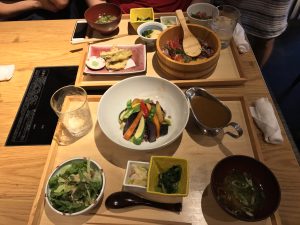The thin red curtains cast a strangely pink glow as the sun’s rays peak over the city skyline and sneak their way into our apartment. It almost simulates a real sunrise, even though surely it’s been hours since the sun rose. It’s about 6:00 or 7:00 am, here in Shinjuku, Tokyo; a surprisingly normal wake up time considering jet lag. We started our day off with a コンビニ (conbini; convenience store) breakfast: I got a strawberry yogurt drink, egg sandwich, and musubi. Surprisingly tasty and filling for the price, time, and long day ahead of us. I don’t think I can even begin to capture all the information and details and everything that Oozaki-san (our tour guide for the day and Aridome-sensei’s good friend) left us with. So I’ll be focusing mainly on highlights and things that stood out to me.
~~~
We met Aridome-sensei’s dear friend (親友; shinyuu), Oozaki-san, at Waseda University. Oozaki-san is a nationally certified tour guide, so we were definitely in for a treat today! After a 上手 (jouzu; skillful) 自己紹介 from Ethan (and shorter ones from the rest of us), we set off for Tsukiji Fish Market. Selinger-sensei and Aridome-sensei both expressed concern that, given my fascination with marine life and vegetarianism, if I would be okay walking through the aisles of Tsukiji, where wholesalers prepare and package the fish they bought earlier (think 5:00 to 7:00 am) at the auction. It’s definitely an interesting question that I’ve been asked before and is perhaps relevant to my own project: If we are to value marine life so highly, especially Japan as an island nation, does that mean we forego consumption of marine life? Or, does consumption of it also convey that reverence? For me, I tend to approach vegetarianism from an environmental perspective; that is, I think the way meat is produced and processed (especially in the United States) is inefficient and leads to a whole host of environmental problems. Also, it’s hard to know exactly where your meat (or any food really) comes from and how it was handled. So processing of fish, like at Tsukiji, doesn’t really bother me. The way I see it, if it’s not the blades of a skilled wholesaler, it could very well be the blade-like teeth of, say, a shark or other predator a trophic level above that fish. More so the case, I was really interested in trying to identify various species as best as I could, to as specific a taxon as I could manage. I was also intrigued by the decisions to either present fish as live fish, whole (dead) fish, or in pieces.


~~~
We also visited numerous shrines and got a really historical view of Tokyo. Apparently, a large portion of it, which encompasses Tsukiji, is reclaimed land. I was also very impressed with the Tokyo skyline, from two separate buildings (I’m blanking on one of them, apologies; the other was the Tokyo Metropolitan Building). I’m usually not much of a city person (some friends from Boston like to joke that I’m from the “countryside”), so I had some mixed feelings about Tokyo. As I was telling Aridome-sensei, I think Tokyo feels more open and less suffocating than a city like New York, where skyscrapers obscure the view of the sky and everything feels grid-like. Maybe it just had to do with the district, but Shinjuku and Ueno had a different, lighter and more modern feel than New York. I also think Tokyo has more green spaces interspersed and the skywalks and monorails help you get off the ground and add a lot of layered complexity to the city. Speaking of transportation, I was impressed by the efficiency and sleekness of Tokyo’s subway system. Definitely rivals New York’s subways in terms of sprawl and Boston’s T in terms of organization and modernity (namely, the T’s blue line). Tokyo subways are a lot more crowded, though, and it kind of made me realize that, besides the lack of natural spaces and being surrounded by concrete/metal faces (which I already knew), cities bother me because of how congested they are. I like efficiency, so moving at a snail’s pace amidst a crowded street or subway and being pressured from behind to keep moving even though I physically can’t is somewhat frustrating for me, I think.
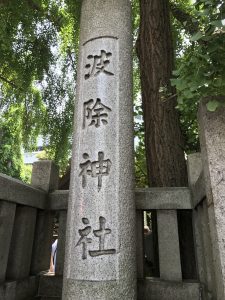
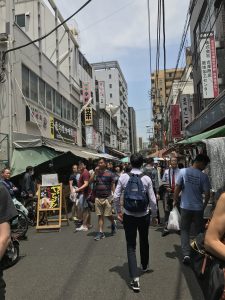
~~~
I was also struck by how difficult it can be to have dietary restrictions in a foreign country. We ate lunch at this wonderful restaurant on the second or third floor of an outdoor-ish mall. They had an English menu, thankfully, but even then they had relatively few vegetarian options. I ended up getting curry again (granted, it was すごくおいしかった = sugoku oishikatta = extremely tasty), but it came with a bunch of sides like miso soup, salad with a peanut and ginger dressing, etc. Later, when we were getting dinner after a long day (I was dragging at this point) at a デパ地下 (depachika; contraction of デパート and 地下; aka, department store basement), Oozaki-san showed me around to the various vegetarian (肉がない; niku ga nai; meatless) options. 本当に肉がないオプションをみせてくれてありがとうございました (hontou ni, niku ga nai option wo misetekurete arigatougozaimashita). I realized it’s really difficult simply browsing and trying to discern what options don’t have meat; I suppose a more active approach (i.e. asking which options are meatless) is probably more effective.
